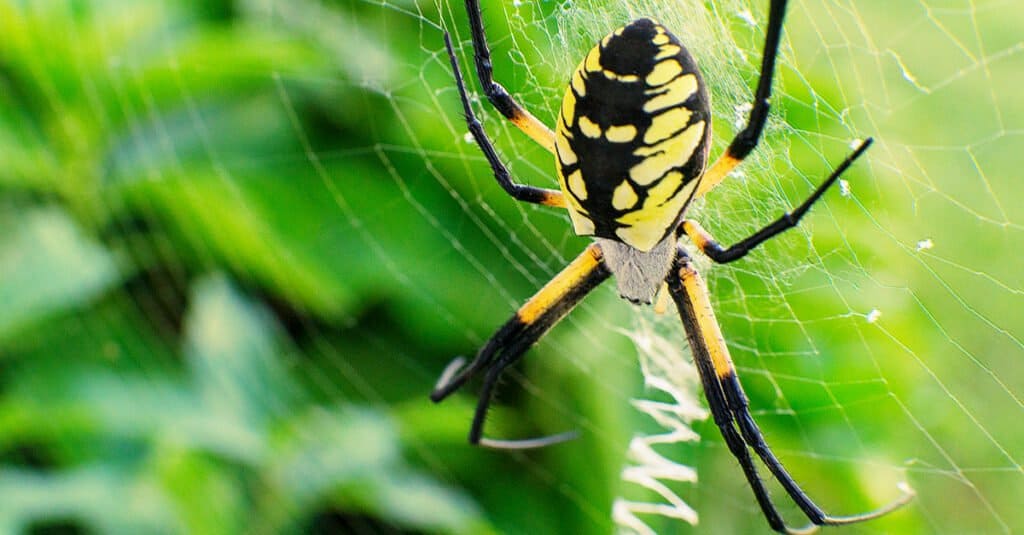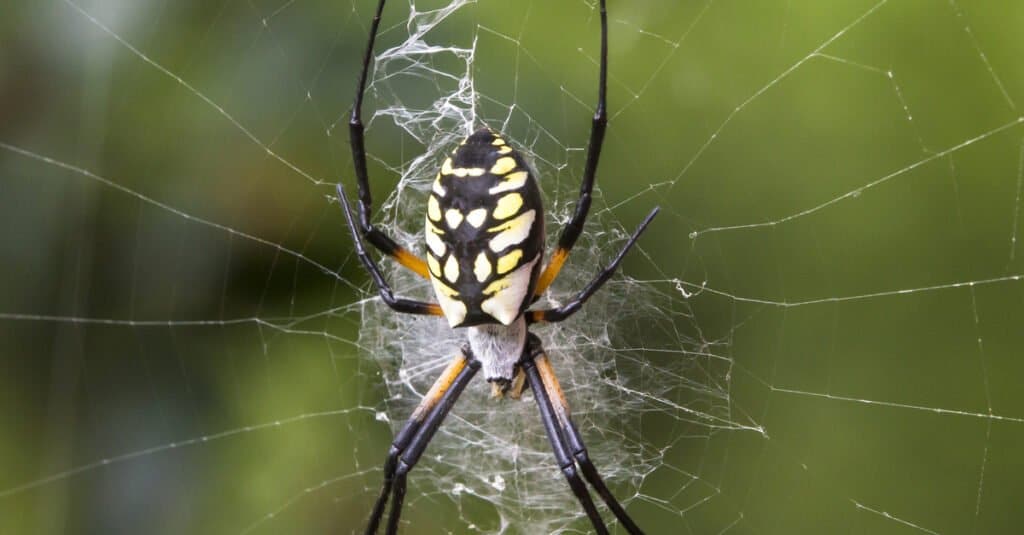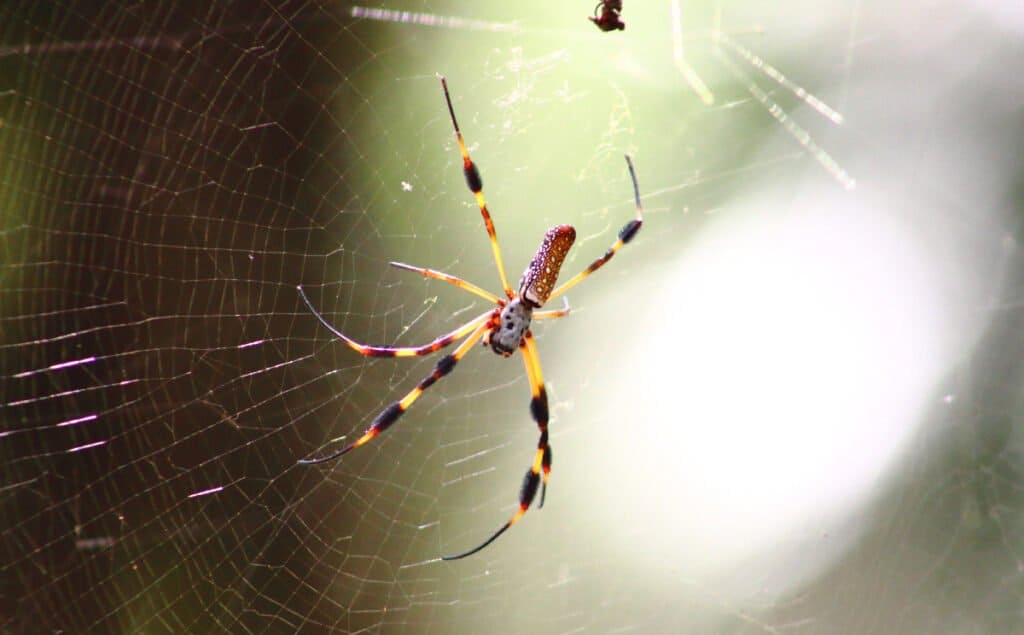Yellow spiders are found throughout the world, and two of these spiders that are most commonly confused for one another are the banana spider and the garden spider. Both of these spiders go by various names, and they can be hard to differentiate with a cursory glance. That’s why we’re going to take a closer look at these creatures in a banana spider vs garden spider comparison. Learn how these spiders are different from one another!
Comparing a Banana Spider and a Garden Spider

| Banana Spider | Garden Spider | |
|---|---|---|
| Size | Length 0.5in-2in body – Up to 5 inches with its leg span | Length: 0.2in-1in – 3-inch legspan |
| Scientific Name | Nephila | Argiope aurantia |
| Color | – Integrates red, yellow, white, and black – Variety of colors on its body, including red and green-yellow – Legs are banded with colors such as red and black or black and yellow with hair at the joints – Long bodies – White spots on its thorax | – Yellow and black – Black body with yellow markings – Legs may be brown near the body – Elongated body with an oval shape |
| Location | – Asia, Africa, Oceania, North America – Prefer to live in warm climates | – North America and Central America |
| Danger to Humans | – Venomous bite that can affect humans – Will lead to redness and mild pain | – Can bite humans – Bite causes pain, redness, and swelling at the site |
| Web | – Orb-shaped and gold – Webs can reach up to 3ft wide | – Orb-shaped and cream-colored – Integrates a dense zig-zag portion in the web called a stabilimentum |
The Key Differences Between a Banana Spider vs Garden Spider

Garden spiders are common in North and Central America, and they’re famous for their unique webs.
©Theodore P. Webb/Shutterstock.com
The most significant differences between a banana spider and a garden spider include their size and coloration. The banana spider is larger than a garden spider, possessing a body that can reach 2 inches long and a total legspan of 5 inches while possessing red, greenish-yellow, black, red, and white colors on its body. The garden spider measures about 1 inch long with a 3-inch legspan and have a black body with yellow markings and some brown on its legs near its body and joints.
These spiders may both have large webs and can be black and yellow, but the differences between them are even greater than that. We’re going to take a closer look at these spiders and show you what makes them unique.
Banana Spider vs Garden Spider: Size
The banana spider is larger than a garden spider. The banana spider is up to 2in long and has a 5-inch legspan, but the garden spider is about 1in long and has a 3-inch legspan. The size difference is noticeable between these spiders, and females of both species are larger than the males.
Banana Spider vs Garden Spider: Scientific Name
The banana spider’s true scientific name will start with Nephila, the genus to which many golden silk orb-weavers belong. Eleven species of spiders belong to this genus. The garden spider’s scientific name is Argiope aurantia, and it’s often called the yellow garden spider.
Although the spiders may look alike, the truth is that they are not even in the same genus as one another.
Banana Spider vs Garden Spider: Color

Garden spiders usually appear black and yellow.
©cliff collings/Shutterstock.com
Both the banana spider and the garden spider can appear black and yellow. The garden spider frequently appears with a black body and yellow markings. The legs may appear brown when they are near the body. The body itself is elongated and in an oval shape.
However, the banana spider can integrate reddish-brown, yellow, black, and white into the colors. This spider has a long body that can be primarily yellow or greenish-yellow with an underlying black as well as white spots or swaths on the body.
Also, these spiders typically have bands of colors on their legs. The leg colors can include red and black or black and yellow. Furthermore, banana spider legs often have tufts of hair at the leg joints. These factors make it easy to differentiate the spiders.
Banana Spider vs Garden Spider: Location
Banana spiders can be found in a larger area than garden spiders. You can find banana spiders in Asia, Africa, Oceania, and North America. They prefer to live in warm climates. Garden spiders live in North America and Central America, but the Agriope genus is more widespread.
Banana Spider vs Garden Spider: Danger to Humans
Both banana spiders and garden spiders are brightly colored, and that has led people to believe that they are dangerous. The banana spider can deliver a bite to humans, but it will only cause redness and mild pain in the recipient. Banana spiders are not dangerous to humans or their pets in the vast majority of cases.
Garden spiders can also bite humans, and their bite can cause pain, redness, and swelling at the site. However, garden spiders are not deadly to human beings.
Although both creatures may look like they are dangerous due to their bright colors, the truth is they are not very dangerous. Furthermore, they prefer to stay away from humans so they can tend to their webs and catch prey.
Banana Spider vs Garden Spider: Web

The golden silk orb-weaver builds a web that can measure over 3ft wide.
©Max Rossa/Shutterstock.com
Garden spiders are also known as writing spiders due to the way they spin their webs. Their webs are reinforced in the middle with a section called a stabilimentum, a dense portion of the web that appears in a zig-zag formation. Their webs are orb-shaped, something they have in common with the banana spider.
Aside from the stabilimentum, the two spiders have similar orb-shaped webs. However, the banana spider uses golden silk instead of the cream-colored silk common in garden spiders.
Many differences exist between a banana spider and a garden spider, but it’s still somewhat easy to confuse one for the other. Knowing the different ways that these animals are unique can help differentiate them.
Either way, these spiders aren’t going to hurt you, and they can be valuable pest removers. If you see them, it’s a good idea to simply let them be.
The photo featured at the top of this post is © Bildagentur Zoonar GmbH/Shutterstock.com
Thank you for reading! Have some feedback for us? Contact the AZ Animals editorial team.







